
Plaça de Catalunya, Barcelona, June 2011
In June 2011, I spent a few days in Barcelona. In May, the city had been the site — one of many across Spain — of a wave of demonstrations by members of the public furious about high unemployment, especially among the young, corruption among politicians, business people and bankers, and the country’s dire economic condition. A manifesto produced by ¡Democracia Real YA! (Real Democracy Now!) outlined the protesters’ demands. A peaceful demonstration in the Plaça de Catalunya in the heart of Barcelona had been brutally suppressed by the police. Just a few months later, the Occupy protests would emerge from the same profound sense of frustration at the absurdly widening gap between those at the top insulated from the effects of the global financial crisis by extreme wealth and ordinary people, who are apparently expected to bear the brunt of the downturn by governments failing to represent their interests.
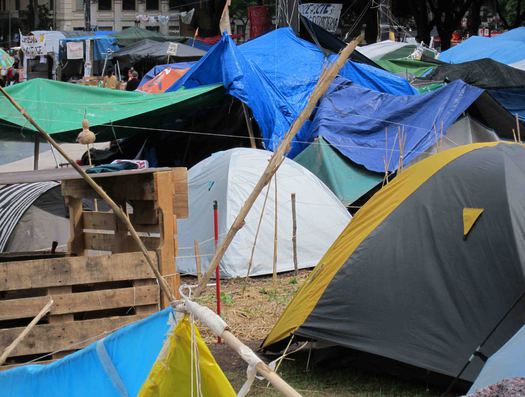
Plaça de Catalunya, Barcelona, June 2011
The Plaça de Catalunya had been cleared, but some of the protesters returned and in early June they still occupied the square. There was a camp of tents at one end and the trees around the edge contained makeshift aerial living platforms lashed together from ropes, planks, poles, railings and plastic sheets. On the ground, the protesters had improvised a loose, carnivalesque village of covered structures and kiosks, where people could go for information, food, company and help. It was a warm day when I was there and the atmosphere was peaceful, cooperative and exciting, even for a visitor, because unfinished things in a state of emergence are always exciting. If the construction of shelters around the square represented a rudimentary form of building — a re-learning of a basic skill in the absence of architects — then the hundreds of handmade banners, signs and messages that covered everything showed, just as clearly, an untutored but inevitable need for something akin to graphic design.
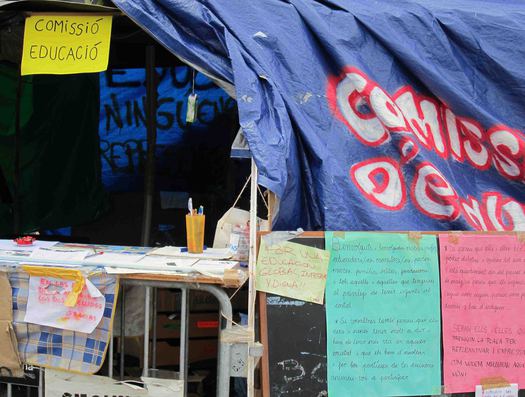
Education commission
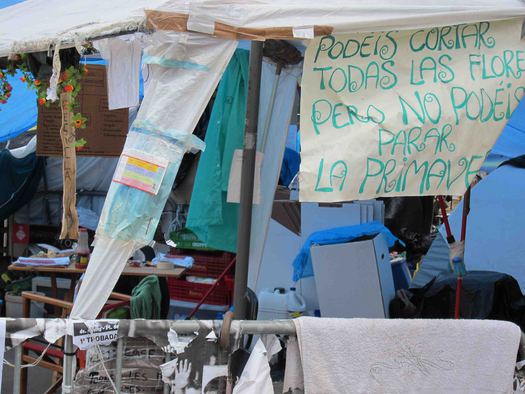
“You can cut all the flowers but you cannot stop the spring”
The pleasure and optimism of strolling in this space came from a utopian reminder of how different it might be if we could somehow start again and devise a new politics and new social structures on the basis of a different set of priorities, values and goals. But this was now and looming over everything as a backdrop, at the top of the square, were the omnipresent billboards, where a Hyundai car ad with a soulful baby gorilla informed shoppers, without irony, that “another way of thinking is possible.” They couldn’t have put it better.
I have shown these pictures a few times in lectures and some designers have been intrigued by the raw but effective DIY design. In some ways, these scenes are not so unusual. They are representative of what happens when people with limited resources, who are engaged in urgent and idealistic collective action, resort to ad hoc “design thinking” and ramshackle bricolage to create the spaces and communications they need. I’m posting the pictures here as a postscript to the two essays about Occupy Wall Street’s occupation of Zuccotti Park as “spaces of political action,” published by Places, and my recent piece about activist posters and protest signs.
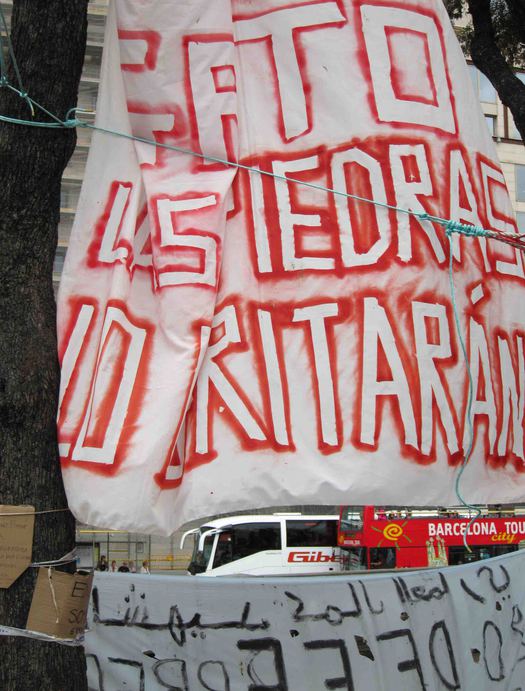
Banners
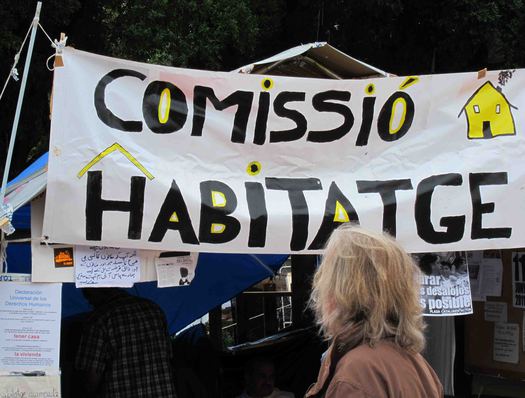
Housing commission
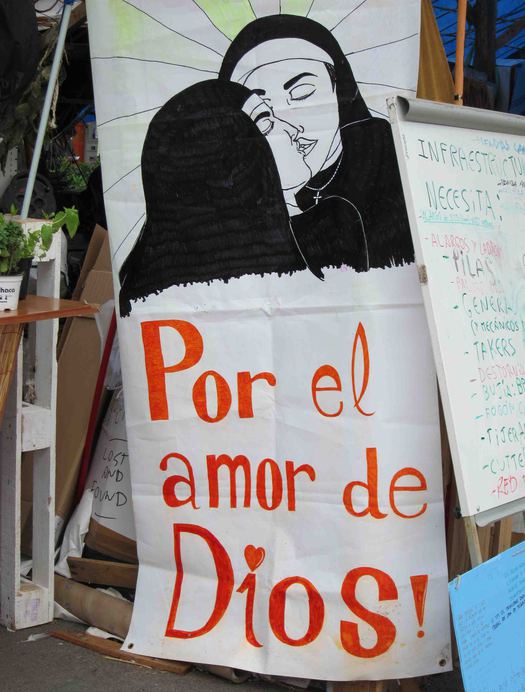
“For the love of God!”
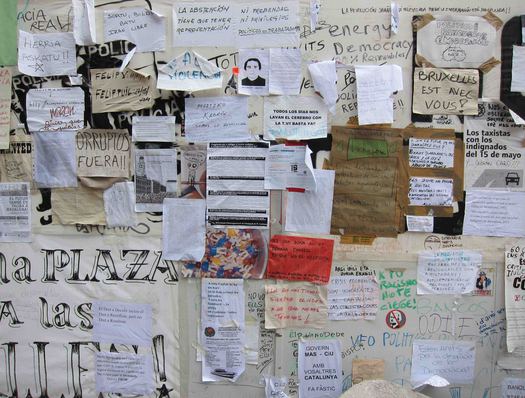
Connections
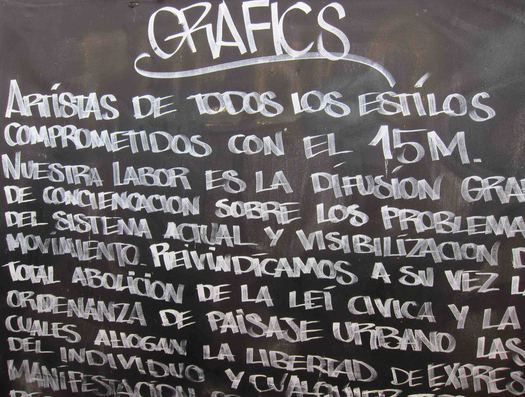
Proposals
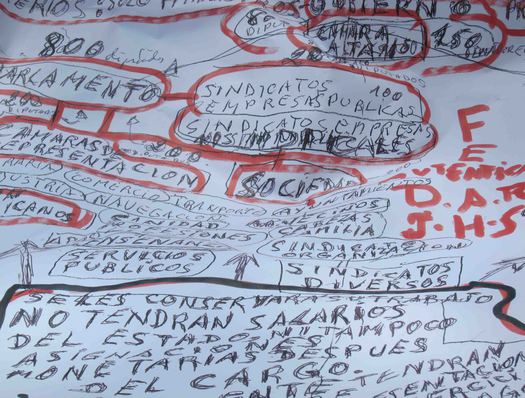
Strategy
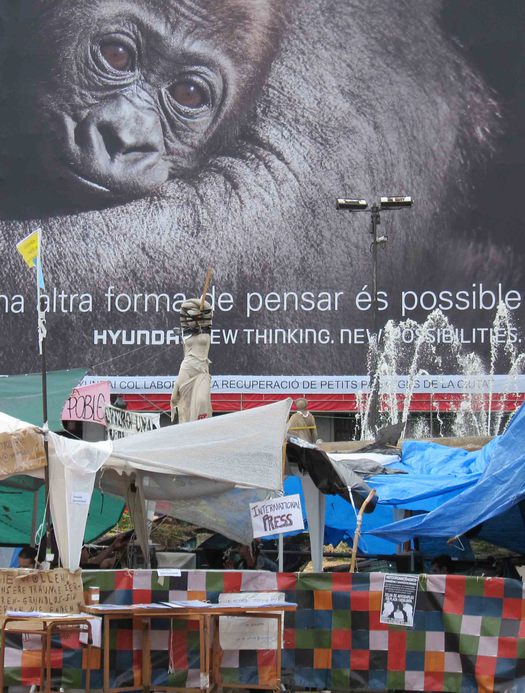
“Another way of thinking is possible.” Hyundai billboard at the top of Plaça de Catalunya
Photographs: Rick Poynor


Comments [15]
http://observatory.designobserver.com/feature/why-the-activist-poster-is-here-to-stay/360edi68/
Why is it that the examples in this post look so strong, urgent and radiate so much credibility while many of the examples in the "activist poster"-post look so slick, distanced and (i don't know how to express it differently) "corporate"?
Could it be that a somewhat naive professionalism and especially our attitude of wanting to be "authors" becomes disfunctional in this kind of context? I am not advocating for designers to "de-learn" important vocational/craft skills ... but maybe we have to reconsider the somewhat missionary approach of "giving people a voice" where they obviously have one.
To me the comparison of both posts shows that the "activist posters" are rather decorating activism. It would be probably a good idea to add "risk taking" to the curriculum of (design) education - next to "typography" and "graphic design I-III".
But - and this is probably the good news - the images in this post clearly show the important role of esthetics in the solution of the current crisis - esthetics as the sum of all attributes which form human perception. there is a lot to do (and to learn) for designers, obviously.
09.24.12
12:20
The problem with graphic design, and other forms of design, as many designers now recognize, is that the practice became so calculating in its commercial targeting of viewers that many of us have lost our faith and trust in it. (All that interminable baloney from branding gurus about the "soul" of the brand.) Authenticity is not a straightforward concept, but here let's just say that we do hunger for it. We want to believe that things are "for real" and that we are making contact with some inner meaning that we can rely upon.
And that's what comes across in these visual expressions: their anonymous creators believe in what they are doing, their cause is the primary goal, and they are doing the best they can with natural talent and limited means. Right now, that credibility, commitment and spirit counts for a lot more than professional gloss. As for what professional designers should do, we have kind of been here before, with the old idea (so easily abused) that designers should learn lessons from the supposed purity of the "vernacular." It's a tricky one.
09.24.12
02:19
It is no surprise that the professionals, whose knowledge and taste regimes come from disciplines that have been moulded precisely in order to serve destructive forms of politics and economics, are at a loss to understand their purpose in this space. Generally this is because places of resistance are intentionally designed to take back power that is ordinarily assumed to be the preserve of professionals. Professional design, therefore, generally has no purpose here, and it shouldn't assume that it does.
This is not to say that there is not an urgent need for design. The responsibility of professionals though is to learn the extent to which they have become disabled by the status quo of their profession. Its not actually that tricky, it just requires some seriously confronting social critique, a recognition of privilege, and a lot of hard work.
09.25.12
12:13
"If you come only to help me, you can go back home. But if you consider my struggle as part of your struggle for survival, then maybe we can work together."
– Aboriginal woman
09.25.12
12:40
Is it a "privilege" to use one's imagination and wish for something better? Are the protesters not using their imaginations? That's ridiculous. We are far from achieving the parity and social and economic justice that many people long for (and that hugely powerful forces resist) and it is clearly going to be a long, hard struggle.
09.25.12
03:55
I am also a bit tired of "design bashing" and more interested in the question what (design) professionalism means in the sphere of the political - which btw. is not necessarily always about resistance. As per Gui Bonsiepe the political/democracy is about "participation and citizens to transform themselves into subjects opening a space for self-determination, and that means a space for a project of one’s own accord."
Reading this statement i was thinking, that it probably is the idea of "the project" which needs some reconsideration. "The project" traditionally knows a limited set of players each assigned a defined role in the design process: the project owner (aka "the client" who poses a question), the designer (as the inventor/creator of an answer) and the audience (the object/target of the answer). In a political sphere this model does not work anymore: The client can be eliminated - the audience is now the project owner or there is simply no "owner" anymore. The designer is part of the audience and the effort to create space for projects. The result of the project is probably not an artefact anymore, the designer is not an author anymore and the audience is not an object anymore …
It is hard to imagine that in this kind of processes professionalism would not be necessary anymore … en contrair. But it is for us to find out what good practice and professionalism means here - beyond patronising on the one side or a purposefully adapted naivity on the other.
There is an interesting post in the Newsletter of Spanish designer Marti Guixe written by Octavi Rofes about "The Design without project":
http://www.guixe.com/newsletter/news12-03.htm
09.25.12
05:17
To a large degree, depending what 'self-aware' and 'politically informed' means, absolutely. It is often synonymous with being 'in design'. And I don't exclude myself from this either. In this case though I don't think I've been all that patronising, mostly because I tried to avoid being disingenuously kind while delivering a critique.
If I conveyed a sense of superiority it was, while unintended and undesired, probably based in feelings derived from my experience of having participated in something similar (Occupy Sydney). When I see these images and hear the descriptions it sounds like working conditions that I am partially familiar with, where things and images mean something different to how professional designers see them. It was always slightly aggravating to have people show pity (rather than solidarity) towards conditions that were hard fought for, that people felt proud of, and which actually have a functionality and meaning so specific to the circumstances that a casual observation by an outsider would totally misinterpret what was going on. That's where my comments are coming from. If they are misplaced I apologise, but I'm yet to understand how they are.
When design journalists and theorist use these events rehearse tired ideas and describe things they seem to know little about in developmental terms such as 'rudimentary', 'untutored', and in 'need' of design, it sounds ignorant, self-serving and privileged.
Unflinching critique is precisely what Papanek did, and Fry still does. With respect, I think what I have said in these comments has more in common with that tradition than this article.
"Why shouldn't designers, in the context of a design website, consider the question of what "professional" practice might have to contribute to that struggle"
I'm not saying they shouldn't. I'm suggesting that when they do, more often than not it is ignorant and self-serving. Compare the quote I posted above and Illich's 'To hell with good intentions' http://www.swaraj.org/illich_hell.htm
09.25.12
05:31
Rejecting the pretensions of professionalism is a form of political critique with a long history. Its only dangerous to those who need to reminded that professionals are responsible for more damage than anyone else on this planet. Such a critique doesn’t mean celebrating ‘unprofessionalism’ (that would continue to accept the problematic binary), it means throwing a critical eye over the normalised conditions of work, qualification, and privileged elitism that our societies foster. That a critique of the design profession would automatically be seen synonymous with design as such (“design bashing”), reflects this very pretension. Design is not the preserve of Designers; they just tend to think that it is.
Bonsiepe’s ideas are interesting but they and their founding concepts are not beyond reproach or rival. See for instance my piece here: http://designphilosophypolitics.informatics.indiana.edu/?p=154 and “Autonomy, Solidarity, Possibility: The Colin Ward Reader” http://www.amazon.com/Autonomy-Solidarity-Possibility-Colin-Reader/dp/1849350205
Your comments that followed Bonsiepe reminded me more of a claim by David Graeber in “Direct Action: An Ethnography”, that the legacy of the Situationists, who attempted to erase the distinction between artist and audience, has been carried on in many punk, activist, and anarchistic forms of practice. Design, in this sense, still has a long way to travel.
09.25.12
05:54
It's dispiriting, though seemingly inevitable, that even people who largely agree with each other find it hard to avoid engaging in fruitless point-scoring.
By the way, this post is a photo-essay to which the text is just a short, scene-setting introduction. It's not intended as a full-blown statement of my own position, which can be found elsewhere.
09.25.12
12:07
Then a homeless man I'll call John got back to the site. John is proudly homeless and has a long record of activism. He spent a lot of time at the site and was largely responsible for how it looked prior to our cleaning. He was agitated, and explained that he made it like that precisely to keep things hidden. As we all knew the police in Sydney were notorious for seizing equipment that made staying at the site more comfortable. The 'mess' effectively functioned as a form camouflage. Even if police on the ground knew what was there, they didn't have to admit to their superiors that they did.
We all discussed the limits and merits of each approach and decided to leave it for a bit. I don't think we'd seen police in days, so it didn't feel as important. 5 minutes later a squad of riot cops arrived to seize the equipment we had made visible, and while we scrambled to protect what we could we lost a lot of it. Afterwards my friend and I felt shattered; good intentions had blown up in our faces.
I'm not trying to be holier than anyone. I'm reacting to a tone in the article that I think is demeaning despite (even because of) the benevolent overtones. I'm trying (perhaps failing) to indicate that professional designers, who have many useful and valuable skills, are not experts in every situation. If they don't recognise this they can do a lot of damage. If you take this situation as 'the world', as Papenek would say, they are the most dangerous profession, or from Clive Dilnot more recently, design has "almost complete irrelevance as a value, or indeed as a profession.”
I know our opinions are generally more similar than different, and I'm glad for that, especially on this site,. I know this because you have supported my opinion in similar critiques against other authors (http://observatory.designobserver.com/entry.html?entry=24858), and I enjoy your writing, even on similar matters. I think it is really important to have allies. But, especially amongst friends, I think it is dishonest to fall into line behind something disagreeable. In this case, even with a few words, I think you have reproduced a very specific problem that goes to the heart of the design profession. It wouldn't take much to fix that and change this into a piece that showed curiosity rather than pity, and solidarity rather than patronage.
09.25.12
08:35
AWAKE #Global Revolution from No Mames Films on Vimeo.
If we could go back to the start and create politics and social structures on the basis of new values, a new set of priorities, and goals for a global community. Our criteria for demonstrations, democracy and design would need to explore the ambiguity between what you term “the raw but effective DIY design” based on “idealistic collective action” and a meaningful message that is clear and not camouflaged.
09.26.12
12:59
At the risk of laboring a point that I hoped was obvious, I am not for a second suggesting that protesters need professional designers to come in and redesign their camps, though designers (such as you) could of course be involved on a collaborative basis and that has certainly happened — for instance in the London Occupy.
There is no pity, "patronage" or (good grief!) intention to "demean" anyone here, and I hope no one else read my brief remarks, or interpreted the photos, in that way. I admire what the Spanish protesters and Occupy protesters are doing and support them and took the photos in exactly the spirit of curiosity you prescribe.
As for the remark you report from Clive Dilnot, taken out of context that certainly sounds like an example of the "design bashing" Florian is concerned about. It's not hard to do from a position of academic detachment, disconnected from the everyday realities, pressures and inevitable compromises of maintaining a design practice. There is much I question and reject about professional design, too, and I've spent years saying it, but in the end, if we think that some kinds of design might have positive value and purpose (because we know from history they can), it makes no sense to endlessly bludgeon and demoralize designers en masse as some fatally misguided group. As I said above, the "case against" has been thoroughly made already. Now let's have a new case for.
09.26.12
03:50
To be very precise though (and I only labour this myself because I think it is getting closer to what I mean) I'm not (or shouldn't be) critiquing your intentions. I'm critiquing what is evident in the writing. To me, language such as 'rudimentary', 'untutored', and in 'need' of design is demeaning, and would be so in a studio environment, let alone when the object of description may actually be a sophisticated, crafty, and conscious response to circumstances beyond the understanding of a casual viewer. It has a structure closer to that of an imposed interpretation by an authority (a writer from a professional publication), not a product of working-with or learning-from as equals in a shared struggle (it would be nice to hear more about what/if you see yourself as struggling against and how you have responded). If other designers endorse the sentiment I see in this article and carry it with them in their work, damage has been done. Not much is learnt other than the need for more 'designers like us'.
Also, the curiosity I meant can't be satisfied through the lens of a camera. What I meant needs and seeks an embedded context – the meaning of the culture from where the shot was taken. The difference shows up in language. For instance, 'collaborating' is not a wrong way to describe working with others at Occupy, but it feels out of place. 'Collaborate' is something I do with designers, academics or artists, not people I've slept beside on the street or waited outside a cop shop for. Just like how I wouldn't describe making dinner with my friends or family as a 'collaboration', there is a difference between the imposition of meaning from different fields of activity and a genuinely shared understanding. This is something ethnographers have struggled with for some time now. Designers and design writers are only just beginning to understand this themselves.
IMO, the best case for a genuinely transformative agenda for changing the designer identity comes from Fry's 'Design Futuring' and 'Design as Politics' (have you written your review of this yet?), both of which include critique as an essential part of a long project of creative destruction.
So as not to do damage to Dilnot, heres a little more context that shows that he too is making a distinction between the dis-ability of designers and the need for design:
"Sustainability is that which most cruelly exposes design. Nothing reveals more sharply both the necessity and inconsequentiality of design: its (absolute) necessity as capacity, and its almost complete irrelevance as a value, or indeed as a profession." 'Sustainability as a Project of History.' Design Philosophy Papers no. 2, 2011.
09.26.12
05:35
09.26.12
05:48
Speaking of Design as Politics:
“If we don’t deeply understand the communities we are trying to serve, then we can not design for impact.” — Tim Brown
(click image for CGI link)
Designing for Impact at the 2012 CGI Annual Meeting:
Tim Brown, Chief Executive Officer, IDEOLinda Tischler, Senior Editor, Fast Company Magazine
@24:50 Opening Plenary Session Moderator: President Bill Clinton, introduces Tim and Linda.
@34:00 Linda brings up the unsustainable argument with Tim.
09.27.12
12:09